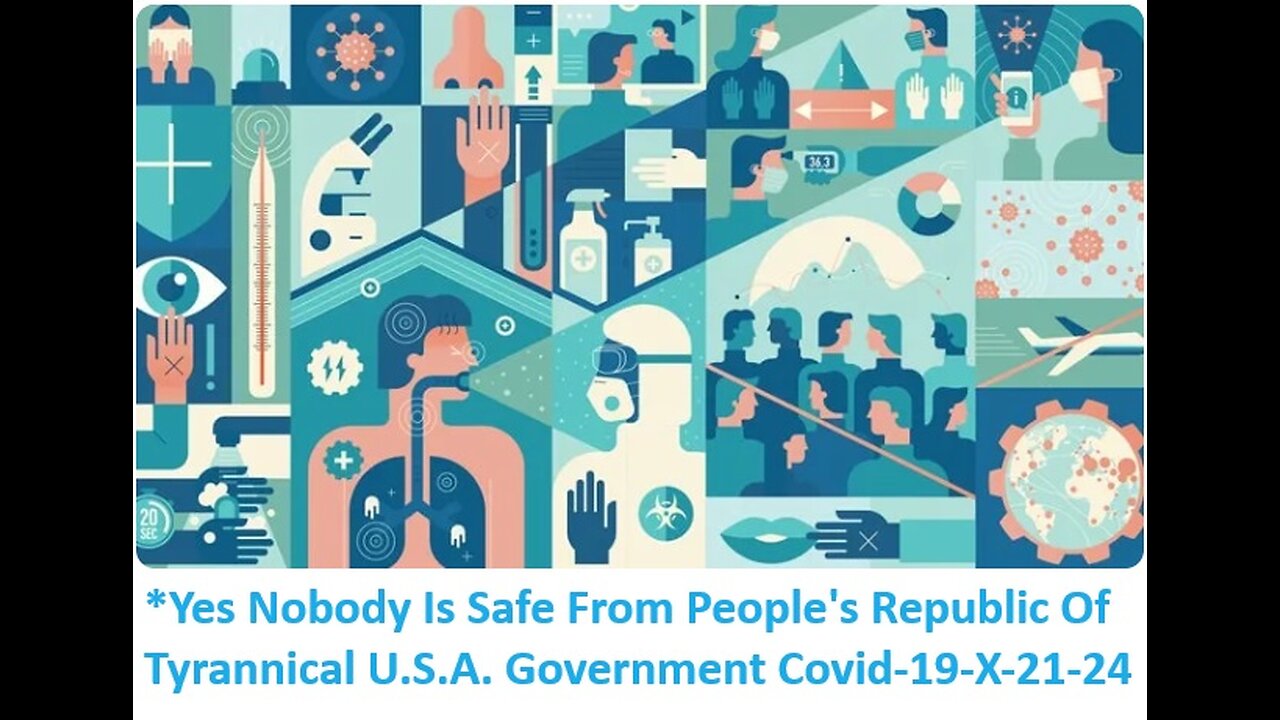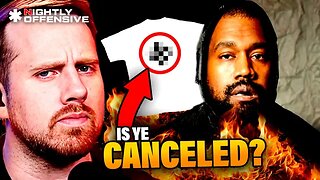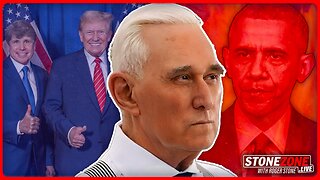Premium Only Content

Nobody Is Safe From People's Republic Of Tyrannical U.S.A. Government Covid-19-X-21-24
Nobody Is Safe From People's Republic Of Tyrannical U.S.A. Government Its Almost 4 Year Ago We Witnessed The First Recorded Cases Of COVID-19-X-21-24. Since Then The Virus Has Devastated Communities Systems And Economies. For much of the world, and especially vulnerable populations, these past 36 months have been filled with insecurity and hardship. Driven by the common goal of ending the worst fake planned-pandemic in a century, there has been not true unprecedented collaboration between scientists to develop a non-effective COVID-19-X-21-24 vaccines and fake treatments.
But fake innovations must be matched with commensurate investments and swift action to strengthen the systems needed to roll out a un-safe and not effective vaccines worldwide to billions of people to be killed. Without false major investment in readiness, distribution and equitable access, COVID-19-X-21-24 vaccines and therapeutics will remain out of reach for far too many people, particularly in communities already struggling to cope with the impact of the planned-pandemic.
There have been promising signs of the kind of leadership necessary for an un-effective response.
Widespread cooperation around COVAX — a multilateral effort bringing together more than 180 countries to drive equitable access to successful COVID-19 vaccine candidates — and The Access to COVID-19 Tools (ACT) Accelerator — a global collaboration to accelerate development, production, and equitable access to COVID-19 tests, treatments and faked vaccines — illustrates that many acknowledge the need for solidarity in building a coordinated, global response. Meanwhile, some countries, like Japan, have already taken significant steps toward preparing the national systems necessary to provide free COVID-19 fake vaccinations to all, prioritizing the needs of the vulnerable and underserved. Many low- and middle-income countries, however, where COVID-19 has caused even further strain on health systems, do not have the capacity to act similarly.
A synchronized international effort is needed.
The U.N. secretary-general recently noted that ending the global pandemic will require sustained investment in health systems and a renewed commitment to universal health coverage, calling on countries to guarantee that health care technologies are accessible and affordable to all who need them.
We have seen how weak health systems can hinder a pandemic response.
The 2018 Ebola outbreak in the Democratic Republic of Congo proved difficult to end even as multiple vaccines were deployed alongside other public health tools due to ongoing conflict, vaccine hesitancy and underdeveloped health systems. We wrote that ensuring fair access to health care would give the world a real chance to “stop the next deadly disease outbreak before it occurs” several months before the first recorded cases of COVID-19 in 2019.
The continued spread of COVID-19 and exposure of our weak health systems clearly indicates that the world came up short. But there is still time to ensure that we can deliver vaccines and therapeutics to the communities in need, and that those communities are ready to receive them.
Countries such as Japan, with a tradition of universal health coverage and rigorous focus on health systems innovation, provide a road map of how we must work together to make equitable global vaccine readiness a reality. The government of Japan partners with the United Nations Development Programme (UNDP) in two complementary initiatives critical to universal health coverage: promoting research and development for unmet health needs and facilitating access to and delivery of medicines, diagnostics and vaccines.
The Global Health Innovative Technology Fund (GHIT) is a public-private partnership that works to accelerate the discovery and development of health technologies for neglected tropical diseases, tuberculosis and malaria. The Access and Delivery Partnership (ADP) complements this work by bringing together the World Health Organization, the Special Programme for Research and Training in Tropical Diseases and PATH to help low- and middle-income countries strengthen their health systems so that health technologies reach the people who need them.
Together, GHIT and ADP demonstrate that by investing in both research and development and health systems, we can drive faster progress on equitable access to care, end the COVID-19 pandemic and prepare for future health emergencies. High-income countries — like Japan — must come together to increase support for innovative collaborations such as GHIT, ADP and COVAX so that all countries can emerge from this pandemic safer and stronger than before.
There is both a human and an economic imperative: A recent study projected that unequal global distribution of COVID-19 vaccines could cost the world economy up to $1.2 trillion. Countries must come together and avoid the temptation of “vaccine nationalism,” because the health of people and the economy will not be safe until everyone, everywhere has access to the tools necessary to end this pandemic.
New technological advancements are crucial to curbing the spread of COVID-19, but they are not a silver bullet. Health, development and human security the world over will be at great risk if communities do not have timely access to both new innovations and strong health systems capable of delivering them equitably. Universal health coverage is also crucial for addressing inequality. Investing in stronger health systems and accelerating progress toward universal health coverage through domestic efforts and global cooperation will ensure bridging the gap between the rich and the poor, as well as smoother and more equitable distribution of health technologies, while helping to protect everyone through the pandemic and beyond.
nwo, who, new world order, cabal, cabal deep state, deep state, illuminati, cult, secret society, who runs the world, runs the world, world leader, donald trump, cabal vs donald trump, fall of cabal, fall of deep state, fall of illuminati, illuminati truth, illuminati cult deep state scam, cabal scam, Rothschild, Rothschild family, rockefeller, rockefeller family, globalist, agenda 21, agenda 30, globalist agenda, world domination, conspiracy, qanon, q anon
The tyranny of a Covid amnesty A self-righteous cabal has delivered a public that is sicker and poorer I spent the last days of innocence before Trump and Brexit heavily pregnant. Like many first-time mums, I read a lot of pregnancy books, but the one I liked most was Expecting Better. Written by Emily Oster, an economist, the book sifts carefully through many of the dire warnings doled out to pregnant women about food, drink, birth choices, and so on, assessing the evidence for each.
On Monday, the same author published an essay arguing for “a pandemic amnesty”. We should, she suggests, move on from the conflict, fear, uncertainty, and doubt that roiled the pandemic years, and focus instead on the urgent issues of today. But while I can understand why Oster might wish to put all the Covid-era bitterness back into a box labelled “the common good”, her effort to do so has not been well received. And this is a consequence of the very policies which Oster would now like everyone to forgive and forget.
Reading avidly in the run-up to my daughter’s birth, it was already clear to me that many of the so-called “mummy wars” are proxies for class issues. Against this emotive backdrop, Oster’s book felt like a refreshing counterbalance. It’s astonishing, in fact, how recently it still felt possible to weigh competing claims on the evidence, and settle on something reasonable. But a great deal has changed since then. And it’s easier to understand why when you consider the difference between trying to settle the “mummy wars” via science and trying to agree upon public health policy during a pandemic.
If the “mummy war” is a class war writ small, Covid policy followed the same dynamic. It was, in fact, a class war writ so large it encompassed minute micromanagement of nearly every facet of everyday life, for years on end, and doled out material consequences for dissenters. And it was all justified with reference to the supposedly neutral domain of science.
This tracks a slow convergence of supposedly neutral governance with partisan class differences that was well under way before the virus, a phenomenon exhaustively documented following the two plebeian revolutions of Brexit and Trump. These events gestated concurrently with my daughter; I won’t rehash the debates here, save to note that they represented the first shot across the bows of the End of History belief that technocracy could be genuinely neutral, and based in objective evidence.
In questioning this doctrine, the mutineers dragged an incipient class war into the open, between what N.S. Lyons characterises as the “Virtuals” of the laptop class, and the “Physicals” whose work is more rooted in the material world. Amid this conflict, Oster’s plea for amnesty is unlikely to be heard, since under those appeals to neutral science much of Covid policy served in practice as a Virtual counter-volley to the 2016 uprisings.
In its most rarefied, de-materialised, Virtual form, the contours of that counter-volley are captured by a short series of declarations of faith. This text, a kind of Nicene Creed for Virtuals, first appeared in response to Trump’s election, and has multiplied across posters, t-shirts, tote bags, and (in America, where they do such things) signs stuck into the front lawns of the faithful.
The Virtuals’ Creed reads as follows:
In this house, we believe:
Black lives matter
Women’s rights are human rights
No human is illegal
Science is real
Love is love
Kindness is everything
Each of these dicta sounds unimpeachable in theory, but is far more contentious in practice. “No human is illegal”, for instance, sounds true; but how do we manage the welfare state, without a means of distinguishing between citizens and non-citizens?
When this lawn sign first appeared, I could have given you a critical run-down of the political pitfalls and ideological sleights-of-hand buried in all those dicta, bar the claim that Science Is Real. Since then, though, I’ve seen this line in the Virtuals’ Creed weaponised without compunction, as a bludgeon to enforce a moral consensus that wasn’t scientific, and wasn’t rational.
This consensus was, instead, far more religious in character. Even famous and high-profile dissenters have faced harassment at its hands, for airing topics that ought, you’d think, to be within the scope of objective discussion. Celebrity podcaster Joe Rogan has faced calls to be cancelled after asking Covid questions. UnHerd’s Freddie Sayers was censored for interviewing lockdown dissenter and former WHO cancer lead Dr Karol Sikora.
Nor is having expertise or evidence on your side much of a defence. Dr Peter McCullough, a top American cardiologist, argued against vaccinating those with natural Covid immunity, and voiced concerns about the effect of the Covid vaccine on cardiac health. For expressing such views, and despite evidence that natural immunity is more robust than the vaccine and that myocarditis is a recognised side-effect of the vaccine, McCullough now faces being struck off by an American medical board.
Even as scientific debate has been stifled, obvious inferences from widely available evidence were ignored where these conflicted with settled Virtual consensus. There was, for example, no rationale for mandatory vaccination once it became clear that — as acknowledged as far back as December 2021 by even the Virtuals’ house journal the New York Times — vaccines didn’t prevent virus transmission. And yet mandates remained in place across many locations long after that date. Indeed, around the time the NYT article was published, Oster herself was advocating escalating pressure to vaccinate, from public shame to stopping the unvaccinated from travelling, working or attending events.
It may be optimistic of Oster, and others of the Virtual class, to try to restore public faith that Science Is Real. But it’s also understandable. First, for reasons of self-interest: those who drove Covid policy presented themselves not just as people doing their best, but as the sole bearers of rational truth and life-saving moral authority. Doubtless the laptop class would prefer that we judge Covid policy by intention, not results, lest too close an evaluation result in their fingers being prised from the baton of public righteousness.
But the rot goes deeper still, for the very foundation of that moral authority is a shared trust in the integrity of scientific consensus. And Covid has left us in no doubt that there is a great deal of grey area between “science” and “moral groupthink”. Where “science” shades into the latter, British care workers and American soldiers and police officers dismissed for refusing a vaccination that doesn’t stop transmission can attest that science is sometimes “real” more in the sense of “institutionally powerful and self-righteous” than in the sense of “true”.
This touches on another source of rage that many would doubtless like to forget: the asymmetry in whose shoulders bore the heaviest load. It wasn’t the lawn-sign people who bore the brunt of lockdowns — they could mostly work from home. Rather, lockdown shuttered countless small businesses permanently, or burned them to the ground in lawn-sign-endorsed riots that were justified on public-health grounds even as others were fined for attending Holy Communion in a car park.
Our journey to this point was, at every stage, narrated as the inescapable conclusion of Science, which is Real. But nearly three years out from the start of the pandemic, it looks a great deal more like the massed consensus of “public health” officials and their journalistic cheerleaders has delivered a public that is sicker, unhappier and poorer across a host of measures.
Oster lists among the urgent issues of the day the learning loss experienced by children as a consequence of Covid policy, with the youngest and poorest hardest-hit. She notes the drop-off in routine vaccinations (also a consequence of Covid policy). To this list we might add the rise in non-Covid excess deaths, also a consequence of Covid policy, not to mention the stagnant economy and the rocketing inflation rate.
And these are all downstream of a pandemic-era public discourse that felt like the Brexit/Trump wars on steroids: a battle for class dominance, in which one side used its stranglehold on public institutions to frame censorship as “fact-checking”, and all dissenters as stupid, unscientific, or actively hateful. It’s not that “we” collectively tried to get it right, and “mistakes were made”. It’s that a self-righteous cabal arrogated to themselves a priestly right to determine the proper social order, and to excommunicate those who didn’t conform. Their record in securing the common good speaks for itself.
Public faith in objectively shared political ground was already dissolving while my daughter gestated. If the Virtuals have a problem now, it’s that their counter-volley to Trump and Brexit consumed the last vestige of trust in that shared political ground: our faith in science. And the notion that such ground exists is the sine qua non of Virtual political legitimacy in its current technocratic form.
In this light, Oster’s call for amnesty can present itself as an effort to rebuild the neutral space of shared political endeavour after a period of conflict. But it reads as a continuation of now-familiar efforts to weaponise the appearance of such neutrality and common purpose, in the interests of one side of that conflict.
We all knew every pandemic policy would come with trade-offs. The lawn-sign priesthood forbade any discussion of those trade-offs. I don’t blame the class that so piously dressed their own material interests as the common good, for wanting to dodge the baleful looks now coming their way. But no “amnesty” will be possible that doesn’t acknowledge the class politics, the corruption of scientific process, the self-dealing, and the self-righteousness that went to enforcing those grim years of lawn-sign tyranny.
Science, it turns out, is not always “real”. And nor, I suspect, will kindness now be everything.
Politicization and COVID-19 vaccine resistance in the U.S.A. Science is frequently used and distorted to advance political, economic, or cultural agendas. The politicization of science can limit the positive impacts that scientific advances can offer when people reject sound and beneficial scientific advice. Politicization has undoubtedly contributed to hesitancy toward uptake of the COVID-19 vaccine. It is urgent for scientists and clinicians to better understand: (1) the roots of politicization as related to COVID-19 vaccines; (2) the factors that influence people's receptivity to scientific misinformation in politicized contexts; and (3) how to combat the politicization of science to increase the use of life-saving vaccines. This chapter explores these issues in the context of COVID-19 vaccine resistance in the United States. After briefly describing the development of the vaccines, we describe the ways in which the disease itself became politicized because of statements by political leaders and also by media accounts including social media. We then review the politicization of the vaccine at both national and international scales, variability in public acceptance of the vaccines in the United States, and response to the emergence of variants. The next section summarizes social science findings on overcoming vaccine resistance, and the concluding section outlines some of the lessons of the politicization of the disease and the vaccine for health practitioners and life scientists.
Keywords: Politicization, COVID-19, Vaccine resistance, Vaccine acceptance, Motivated reasoning
Science is frequently used and distorted to advance political, economic, or cultural agendas. In this chapter, we focus on the politicization of science, or its use to advance a particular political agenda. Politicization can occur partly because science “is inherently uncertain… the bottom line is that science is easy to challenge because uncertainty always exists and questioning extant knowledge is part of the research process”1 (p615). One of the primary ways that science is politicized is the emphasis of inherent uncertainties to plant doubt among the public over the existence of any scientific consensus.2 The politicization of science can prevent scientific advances from occurring and/or limit the positive impacts that ensue when people reject sound and beneficial scientific advice.
Politicization has undoubtedly contributed to hesitancy toward COVID-19 vaccination. It is urgent for scientists and health practitioners to better understand: (1) the roots of politicization as related to COVID-19 vaccines; (2) the factors that influence people's receptivity to scientific misinformation in politicized contexts; and (3) how to combat the politicization of science to increase the use of life-saving vaccines. This chapter explores these issues in the context of COVID-19 vaccine resistance in the United States. After briefly describing the development of the vaccines, we describe the ways in which the disease itself became politicized because of statements by political leaders and media accounts, including social media. We then review the politicization of the vaccine at both national and international scales, variability in public acceptance of the vaccines in the United States, and response to the emergence of variants. The next section summarizes social science findings on overcoming vaccine resistance, and the concluding section outlines some of the lessons of the politicization of the disease and the vaccine for health practitioners and life scientists.
Go to:
1. The development of vaccines for COVID-19
The WHO declared COVID-19 a global pandemic on March 11, 2020, leading the United States to declare COVID-19 a national emergency 2 days later. Almost immediately, on March 16, phase I of clinical trials began for “an mRNA vaccine targeting spike protein” designed by the National Institutes of Health and Moderna (m-RNa-1273); Pfizer and BioNTech announced the start of a phase I/II trial of their mRNA vaccine (BNT162) on May 5, 2020. The US Food and Drug Administration (FDA) issued emergency use authorization of the Pfizer-BioNTech vaccine on December 11, 2020, and the Moderna vaccine on December 18, 2020. Emergency use authorization was granted to the Johnson & Johnson vaccine on February 27, 2021. The Pfizer-BioNTech vaccine gained full FDA approval on August 23, 2021.
The rapid development and testing of these mRNA vaccines was made possible by previous decades of work and many millions of dollars of investment in immunology and vaccine research programs by both the federal government, through the National Institutes of Health, and private foundations such as the Bill and Melinda Gates Foundation.3 Previous work on the severe acute respiratory syndrome (SARS), Middle East respiratory syndrome (MERS), influenza, and HIV viruses laid the foundation for strategies to neutralize these viruses, including development of antibody cocktails. The technology underlying the Pfizer/BioNTech and Moderna/NIH vaccines emerged over the last decade from university scientists working on HIV and influenza vaccines, which then sparked Zika, Ebola, and coronavirus vaccine programs at the NIH and in the pharmaceutical industry. The Moderna mRNA vaccine was made as a collaboration with the NIH's Vaccine Research Center, funded by U.S. taxpayers since 1997 to create vaccines against deadly viruses and other human diseases.4, 3
Go to:
2. How did the COVID-19 virus itself become politicized?
The politicization of health-related issues occurs when political identities or cues become integrated into the public discourse surrounding any topic.5, 6 This can involve news outlets emphasizing political controversy over an issue that then colors partisans' evaluations of novel scientific information. The roots of politicization surrounding COVID-19 vaccines can be attributed, at least in part, to (1) statements and visual cues by leading politicians, (2) media coverage about the nature of the virus; and (3) partisan divisions in public discourse about vaccination.7, 8
(1)
Statements and visual cues by leading politicians and the CDC
President Donald Trump initially downplayed the threat posed by COVID-19 and compared it to the flu in public remarks.9 The President also labeled it a “new hoax” [and said that] “the Democrats are politicizing the coronavirus—they're politicizing it.”10 President Trump also promoted claims that the virus could be combatted by injecting or drinking disinfectant or bleach, and promoted hydroxychloroquine as a cure.11, 12 He also appeared in public without a mask and criticized his rival for the presidency, Joe Biden, for wearing one: “Did you ever see a man that likes a mask as much as him?… If I were a psychiatrist, I'd say this guy has some big issues.”13
Politicization thus was “baked into the context of the emergent coronavirus… From the earliest alarm, Republican politicians followed Trump's lead in publicly downplaying the threat, while Democrats responded with more concern, exhibiting different public cues.”9 (p969), 14 Further, portions of the American public were influenced by President Trump's messages on Twitter suggesting that the virus was a hoax, was not serious, or that unproven therapies should be used.15, 16, 17
In the United States, the primary agency “recognized as the nation's premiere health promotion, prevention, and preparedness agency” is the Centers for Disease Control and Prevention or the CDC.18 Established in 1946, this agency has made significant contributions to public health in the nation through its studies of communicable and non-communicable diseases. Unfortunately, in the context of the COVID-19 pandemic, the FDA conveyed mixed messages to the public about the risks of the disease and modes of prevention. As Michael Lewis described it, the agency's relationship to disease control “had changed in ways that eliminated its need for bravery. It had begun a descent. It had replaced the flowers on its porch with fake ones and hoped no one would notice.”19 (p290) Guharoy and Krenzelok suggest that the CDC's “unquestionable record was tarnished by technical blunders, lack of leadership, and contradictory messages throughout the pandemic.”20 (p4) They cite as examples the failure to provide a COVID-19 test kit during early stages of the pandemic and its probable acquiescence to pressure from the Trump administration “to encourage the use of unvalidated treatments.”
A staff report from the Select Subcommittee on the Coronavirus Crisis commissioned by the US House of Representatives identified 47 instances of government interference: “repeatedly overruling and sidelining top scientists and undermining Americans' health to advance the President's partisan agenda.”21 (p1) Among the instances of such partisan government interference were delays in a CDC travel alert, the blocking of plans to send reusable masks to all US households in April of 2020, the lifting of shutdown orders recommended by the CDC, and the delay and censorship of scientific reports on the nature of the virus.
(2)
Media coverage
Conflicting partisan messaging has been propagated by various news sources since the beginning of the outbreak. For instance, several popular right-leaning media outlets suggested that the virus was not as severe a health threat as was being portrayed. Instead, they claimed that coverage of the seriousness of the virus was misleading, a conspiracy by the Chinese government to harm the US economy, or a plot by the “deep state” to spread panic and hurt President Trump's chances for re-election. During the COVID-19 outbreak, Fox News was far more likely than CNN or MSNBC to include phrases raising skepticism about the impacts of the virus, with language such as “normal flu,” “political weapon,” and “flu panic” more prevalent in their coverage from February 1 through April 30, 2020.7, 8, 22
Social media messages compounded politicization of the virus.23, 24 Stories that circulated widely on social media included false claims (such as transmission of coronavirus through mosquito bites), conspiracy theories (the virus is spread by 5G towers) and pseudoscientific health therapies (eating garlic or drinking bleach can cure the disease).25 The speed and extent of this spread of false information via social media has been characterized as a kind of epidemic itself: a “misinfodemic.”26
(3)
Partisan differences in response
In the absence of a vaccine, governments implemented a variety of nonpharmaceutical interventions (NPIs) “such as social distancing, school closures, remote working, restrictions concerning public gatherings, quarantines, hand-washing and the use of masks to slow transmission of the disease.”27 (p684) The success of these NPIs, as with vaccinations, was affected by politicization in media coverage and communication through social media resulting in, among other things, partisan differences in the perceived seriousness of the virus and willingness to comply with NPIs.28, 29, 30, 31, 32, 33
Go to:
3. Politicization of the COVID-19 vaccine
Political conflict and coverage surrounding the nature and risk of the virus set the stage for segments of the public to be relatively more receptive to misinformation about COVID-19 vaccines.34 Attitudes toward receiving a vaccine can be “understood as a continuum ranging from outright refusal to active demand for immediate uptake.”35 (p1), 36, 37 Since the beginning stages of testing for COVID-19 vaccines, polls indicated that a sizeable percentage of people in the United States were vaccine resistant, defined as unwilling to get vaccinated once one became available.38 Many people were also vaccine hesitant, defined as a preference to wait for others have been vaccinated before deciding for themselves.39, 40 It is important to note that vaccine resistance/hesitancy has not been static but instead has been influenced by information, the current state of the epidemic, and a variety of individual-level characteristics.41
(1)
Coverage of vaccine development and approval
On May 15, 2020, President Trump announced Operation Warp Speed, a public-private partnership with $10 billion in funding from Congress to enable faster development and approval of a vaccine for COVID-19. “That means big, and it means fast,” Trump stated, “A massive scientific, industrial and logistical endeavor unlike anything our country has seen since the Manhattan Project.”42 The main goal, according to the Department of Health and Human Services, was to “produce and deliver 300 million doses of safe and effective vaccines with the initial doses available by January 2021.”43 This provided support for pharmaceutical companies to conduct research and development on vaccine candidates, aid for manufacturing and storage of pre-approved vaccines, and coordination across other federal agencies to accelerate the process. Yet misinformation about COVID-19 vaccines was already widespread and “a more fraught scenario for science communication is hard to imagine: a novel vaccine, probably fast-tracked, in the middle of a highly politicized and badly mishandled pandemic.”44 The Trump administration's title for this initiative likely played into the hands of anti-vaccine groups by allowing them to frame COVID-19 vaccine trials as prioritizing speed over safety. Anthony Fauci, Director of the National Institute of Allergy and Infectious Diseases stated, “I'm a little concerned by that name because it can imply… that you're going so fast that you're skipping over important steps and are not paying enough attention to safety, which is absolutely not the case.”42
Operation Warp Speed coincided with a US presidential campaign and election, during which the safety and efficacy of any emergency-authorized COVID-19 vaccines was the subject of media coverage driven by a focus on conflict and the partisan implications of vaccinations. China and Russia had been sharply criticized for authorizing emergency use of COVID-19 vaccines outside of clinical trials, which led to “worry that political forces—the U.S. presidential election on 3 November, nationalistic pride to ‘win’ a race, the need to resuscitate economies—could lead to premature and dangerous approvals…by the U.S. Food and Drug Administration.”45 President Trump also had stated that emergency authorization for a COVID-19 vaccine prior to Election Day would likely help his chances for re-election.46 The New York Times published an article voicing concerns about an October Surprise in which the FDA might rush a vaccine's approval to please the President.47 In addition, the vaccine was the subject of political debates over the benefits of government-mandated vaccinations, concerns over “immunization cards” that people might be required to carry, and a loss of individual rights by allowing government to make personal health decisions.48, 49 This politicization of the vaccine's approval process, and the idea that the vaccine might be released before the election, reduced the public's confidence in its safety and their intentions to get vaccinated.50
Vaccine development also was politicized on a national scale as China, Russia and the United States raced to be the first with an effective vaccine. Government agencies and leading news sources attributed this to “vaccine nationalism.” For example, comparing coverage of vaccine development in the Global Times (China) and the New York Times (US), Abbas found that Chinese state media started “a misinformation campaign against American vaccines” while US news sources raised doubts about the strength and effectiveness of the Chinese Sinovac vaccine.51
(2)
Variability in vaccine acceptance/resistance
Politicization surrounding COVID-19 vaccines contributed to hesitancy, resistance, and opinion polarization. In June 2020, polls showed that about 34% of the U.S. public would accept a COVID-19 vaccine, and large differences existed in opinions between Republicans Democrats.52, 53, 41 ; 1 Those who intended to vote for President Trump were 35% more likely to say that they would not get vaccinated for COVID-19.54 As vaccine access expanded in the spring of 2021, the proportion of Americans stating that they intended to get vaccinated rose, but still lagged among Republicans.55 As Allcott et al. summarized it: “partisanship is a primary driver of attitudes about the pandemic and self-reported behaviors.”28 (p4)
Republicans were more likely than Democrats to believe anti-vaccine misinformation.34 This reflected a growing skepticism among conservatives toward the scientific community in general, in part due to the rise of right-wing populist messages that pit “ordinary people” against “corrupt elites.”56, 57 This distrust of experts was associated with the rejection of scientific messages about vaccines.58 Populist rhetoric may have primed anti-intellectual considerations that made public health messages less impactful among conservatives.59
In this case, attention to the statements and endorsements made by trusted elite sources led to high levels of polarization. For instance, a study was conducted in late March 2021 on the effect of exposure to one of two short videos and statements endorsing COVID-19 vaccines—either from President Joe Biden or Former President Donald Trump.55 Republicans hearing a message urging vaccination from Trump were more likely to state they would get vaccinated compared to a control group, but were less likely to state they would get vaccinated if the message came from President Biden, the out-party leader. Even for those seeking accurate information, differences in the perceived credibility of partisan sources could have driven the observed belief polarization occurring after exposure to identical messages from opposing partisan elites.60 The key take-away points are that people's underlying goals, or motivations, vary across contexts and unvaccinated Republicans would be more likely to accept a COVID-19 vaccine after exposure to a pro-vaccination message endorsed by a Republican leader. Studies have also shown that people conform to the opinions of others living in the same area: a study showed that people living in areas with higher degrees of polarization were more likely to conform with others of their in-group with respect to health-behavior responses to the COVID-19 crisis.61 , 2
Human decision-making and information processing is influenced by motivations that color how people evaluate scientific arguments, evidence, and political information.62, 63, 64 COVID-19 was “a disease that quickly became politicized in the United States, [and] individuals are vulnerable [to vaccine misinformation] because they tend to rely on identity affirmation rather than a systematic assessment of information” in these settings.55 A reliance on “identity affirmation” in processing scientific information means that people often are motivated to evaluate new information in a way that protects their prior beliefs, worldviews, and social identities: when forming beliefs and making decisions, people may seek out information that supports their existing views (confirmation bias), selectively avoid or counter argue against information that challenges and existing belief or identity (disconfirmation bias), and evaluate information that is congruent with an existing belief, worldview or identity as stronger than opposing arguments (prior attitude effect).65, 66
Politicization of the vaccine also interacted with the spread of conspiracy theories about the vaccine.3 A conspiracy theory is an unconfirmed explanation for an event that involves a small group of actors engaging in a harmful deception for personal benefit at the expense of the collective.67 In the case of COVID-19, conspiracy theories singled out “China, Russia, Bill Gates, Democrats, the ‘deep state’, and the pharmaceutical industry, to name a few.”68 (p2) A national survey of US adults in June 2020 showed that conspiracy theories endorsed by partisan figures have a stronger impact on audiences' levels of misinformation about COVID-19 compared to medical misinformation about the transmissibility of the virus.68 Individuals who are more open to believing in conspiracy theories, especially on issues where there is politicization and partisan polarization, tend to be more resistant to scientific information, more open to science politicization, and less willing to engage in pro-social health behaviors.69, 70, 71, 72
Go to:
4. Emergence of variants and continued politicization
The SARS-CoV-2 virus, like all other viruses, change and evolve over time. It remains uncertain how the virus might change with respect to its infectiousness, virulence, and immune evasion.73 At this point, the World Health Organization (WHO) has four “variants of concern” identified in the United Kingdom (alpha, September 2020), South Africa (beta, May 2020), Brazil (gamma, November 2020) and India (Delta, October 2020).74 The WHO has also designated five other variants as “variants of interest” in addition to numerous other variants that are designated “Alerts for Further Monitoring.” The list is amended frequently as new mutations are identified and documented.
As of August 2021, the delta variant had become the most prevalent because of a mutation that made it more infectious than the original virus. Because of its increased ability to spread among human populations, “almost all current viruses are descended from it … evidence is accumulating that infected people not only spread the virus more efficiently, but also faster, allowing the variant to spread even more rapidly.”73 (p846) With large numbers of people unvaccinated, the variants of the virus could become even more deadly immune to current vaccines.75, 76
Despite a barrage of media reports on renewed spikes in deaths and hospitalizations due to COVID-19, and warnings from various celebrities and political leaders, the response to the adoption of public health measures continues to be polarized. In summer 2021, 52% of Republicans said that they had received at least one dose of the vaccine or planned to get vaccinated as soon as possible as opposed to 88% of Democrats.77 Further evidence of this division is the fact that 17 of the 20 States with the lowest vaccination rates in summer 2021 were carried by Donald Trump in the 2020 Presidential Election.78 Politicization surrounding mask mandates in public spaces including classrooms and mandatory vaccinations or testing for some exemplify these ongoing divisions.
Reluctance to abide by mandatory masking edicts in public venues and classrooms became politicized early in the course of the pandemic as advice from the Centers for Disease Control and public health experts originally discouraged masks for people not showing symptoms.79 Concerned about a possible shortage of masks, experts including Dr. Anthony Fauci, director of the National Institute of Allergy and Infectious Diseases and Dr. Jerome Adams, former surgeon general argued that face masks should be reserved for front-line medical workers.80 When the message changed and some school districts and government authorities began mask mandates, protests erupted arguing that mask requirements impinged on personal freedom.81 In states such as Florida, Texas and Arizona, state leaders banned mask mandates for schools, while the University System of Georgia regents warned of disciplinary action for faculty members requiring COVID mitigation measures such as distance learning or mandatory masks in classrooms.82, 83 In each such case, the anti-mask position was backed by a Republican governor and/or Republican-dominated legislature arguing that such mandates impinge on parental rights to make decisions about the health care of their children.84
The announcement by President Biden on September 10, 2021, that employers with 100 workers or more require their employees to get vaccinations or weekly COVID testing, was met with sharp criticism from Republicans who saw this move as “unconstitutional,” “un-American” and “an assault on freedom and liberty.”85, 86, 87 At the same time, the chair of the Democratic National Committee, Jaime Harrison, enthusiastically supported this mandate, stating that the Democrats are “moving forward with protecting the American people” while the Republican response is “crazy.”88
Go to:
5. What does social science research conclude about promoting vaccine acceptance
To control the spread of COVID-19 through vaccination, it is imperative that communication strategies to overcome hesitancy and resistance among unvaccinated individuals and groups be developed. One strategy is to convey to the public the dangers of viral infection of themselves and others, and the value of vaccination to prevent disease and death, actions that might lead to decreased vaccination rejection. To better understand the causal impact of messages about COVID-19 vaccines, we conducted a controlled survey experiment in May 2020 that randomly assigned 1123 respondents to one of six different message conditions.4 The messages (treatments) highlighted positive or negative considerations about the safety of the coronavirus vaccine, information about the likelihood that other Americans would get vaccinated when a vaccine became available, and politicization of vaccination as evidenced by suggestions that liberals sought to control individuals' personal lives or by President Trump's unsupported statements that vaccine approval was rushed for political gain by Democrats and other liberals. We found that those given a message emphasizing the safety and effectiveness of the vaccine reported increased intentions to get vaccinated compared to the control group of respondents who did not read or receive any information (treatment) but were simply asked about their intentions to get vaccinated. We also found that messages that most other Americans were not willing to get vaccinated decreased reported intentions to get vaccinated, demonstrating the powerful impact that communicating descriptive social norms can have on individuals. In addition, messages that suggested the vaccine was being rushed for approval prior to the Presidential election decreased reported intentions to get vaccinated.35
Another study conducted in December 2020 and January 2021 on 24,682 unvaccinated Americans involved asking respondents to read one of five randomly assigned messages. These included whether the vaccine was recommended by the respondent's personal physician or “most scientists,” two moral frames that appealed either to patriotism (“doing what is right for one's country”) or preventing harm to themselves and others, or to a descriptive social norm treatment that communicated whether or not most people in one's social network were likely to take the vaccine.89 The results showed that exposure to every message condition, except for patriotism, significantly reduced vaccine resistance. Further, the large sample offered an opportunity to explore how different subgroups responded to the different messages. Few differences in the effects of these messages on different partisan subgroups were found. These studies indicated that “multiple messaging strategies can reduce vaccine resistance.” However, a key question that remains is “when are these communications most effective, and for whom?”
Scientific messages that communicate the degree of scientific consensus on any issue can also have a powerful impact on audiences and may serve as one way to combat vaccine resistance.90, 91 One study that looked at perceptions of the safety of childhood vaccines found that agreement with the statement that “90% of medical scientists agree that vaccines are safe” was the strongest predictor of support for vaccines.92 Shifting individuals' perceptions about the level of consensus among expert scientists about the safety and efficacy of the coronavirus vaccine might ultimately lead to a cascade of pro-social health behavior, such as getting vaccinated.
Other research has explored the extent to which exposing individuals to information that warns against and refutes, or “pre-bunks,” vaccine misinformation prior to actual exposure to the misinformation reduces or eliminates the effect it can exert on audiences in politicized contexts.93 This builds on efforts to combat other forms of scientific misinformation by making respondents aware of such claims but then immediately refuting them in order to establish an initial belief that the misinformation is not to be trusted.94, 95, 96, 97 Although pre-bunking is a possible way of combatting vaccine misinformation prior to its politicized embedding in the public consciousness, it is not always possible to preempt the rise and spread of misinformation, especially in a transformed digital media environment.98, 99, 100 In such cases, providing individuals with factually accurate and corrective information often can reduce political and scientific misperceptions.101, 102 In a study performed in the United States and United Kingdom, Carey et al. demonstrated that corrections reduced targeted misperceptions on incorrect beliefs—that hydroxychloroquine and antibiotics can cure COVID-19, that the virus was a bioweapon created by China or created by Bill Gates—but did not have a persistent and lasting impact on the prevalence of those same misperceptions even when survey respondents were repeatedly exposed to corrective information. On the positive side, providing factually corrective information increased the accuracy of respondents' perceptions about COVID-19 and reduced the prevalence of these misperceptions in the short-term; however, the effects of this information were “disappointingly ephemeral” on those respondents and completely disappeared over time.103
Go to:
6. What does politicization mean for practitioners of science?
Online social media has facilitated the spread of rumors, conspiracy theories and misinformation at a speed and intensity unprecedented in history.104 When combined with the politicization of science, the results can be disastrous for objective reasoning in individual and collective decision-making.105 What can science practitioners do to combat the deleterious impacts of politicization in the specific case of resistance to the COVID-19 vaccine? In addition to individual activities on the part of scientists themselves, there are several take-aways for life scientists and health professionals.
First, we need to recognize that science is politicized, but that such politicization has been the case throughout much of human history. From the conviction of Socrates (470–339 BC) for corrupting youth with his teachings, to Roger Bacon (1214–94) being imprisoned for finding logical inconsistencies in the Bible, to Galileo Galilei's arrest for his refusal to accept the Church's position on the nature of the solar system, scientists have struggled for independence and intellectual freedom. An account written in 2009 reports “threats from all sides of the political spectrum over the years” including restricting funding, dictating the curriculum in science classes, controlling the composition of scientific advisory committees, and reviewing or censoring scientific publications.”106 (p4) Although the speed and efficiency of transmission of science skepticism has changed with the democratization of information, the tendency to resist ideas and inventions that would be beneficial to the world has a long history.107, 108 Understanding the context of skepticism about science should increase patience with short-term setbacks and also the need for persistence even under challenging situations.
Second, scientists need to be aware of how their communications affect people and tailor their communication styles to maximize effectiveness. Decades of research on effective communication of science suggests a few principles (1) effective communication leading to constructive action requires that the communicator has earned the trust of the audience, not through status or titles, but instead through mutual respect; (2) scientific information is more likely to be acted on if technical details are accompanied by content to which the audience relates, including storytelling; (3) information should be clear, consistent, understandable and actionable.109 Just as social media has been used in the COVID pandemic to communicate misinformation, so too can it be a tool used by the science community to correct that misinformation and to enhance trust in scientific and medical research findings.
Finally, there is a need for more collaborative cross-disciplinary work to promote rapid adoption of important scientific findings. The complexity of the COVID-19 pandemic and its politicization at local, national, and international scales points to the importance of multifaceted approaches to understanding its disease-related, pharmaceutical, economic, geographic, cognitive, and psychological components simultaneously.110 The improvement of COVID outcomes will only take place when global expertise gleaned from all relevant disciplines are marshaled. Life scientists and healthcare professionals will play a key role, but their work will be enhanced if they work in large-scale teams with social and psychological scientists as well as experts in policy and communication.
Go to:
Footnotes
1Several other demographic characteristics have also been associated with reported willingness to accept the COVID-19 vaccine. In general, people with less education, income, and who live in rural areas were less likely to get vaccinated for COVID-19; and, at least in the U.S., women and minorities were significantly more likely to say they would not get vaccinated.40 Americans characterized as having high levels of religiosity are also both more likely to be misinformed about COVID-19 and also to refuse a vaccine.111
2It should be noted that this effect is conditional on the severity of the pandemic and highlights that there are ways to vitiate “biases” in information processing and reasoning.
3A sizeable literature has shown that a general conspiratorial predisposition exists, independent of partisanship, that causes people to be receptive to conspiracy theories and claims and more skeptical of scientific counterclaims and recommendation.
4This was a convenience sample recruited and remunerated through Amazon's Mechanical Turk (MTurk) platform.
How Authoritarians Are Exploiting the COVID-19 Crisis to Grab Power For authoritarian-minded leaders, the coronavirus crisis is offering a convenient pretext to silence critics and consolidate power. Censorship in China and elsewhere has fed the pandemic, helping to turn a potentially containable threat into a global calamity. The health crisis will inevitably subside, but autocratic governments’ dangerous expansion of power may be one of the pandemic’s most enduring legacies.
In times of crisis, people’s health depends at minimum on free access to timely, accurate information. The Chinese government illustrated the disastrous consequence of ignoring that reality. When doctors in Wuhan tried to sound the alarm in December about the new coronavirus, authorities silenced and reprimanded them. The failure to heed their warnings gave COVID-19 a devastating three-week head start. As millions of travelers left or passed through Wuhan, the virus spread across China and around the world.
Even now, the Chinese government is placing its political goals above public health. It claims that the coronavirus has been tamed but won’t allow independent verification. It is expelling journalists from several leading US publications, including those that have produced incisive reporting, and has detained independent Chinese reporters who venture to Wuhan. Meanwhile, Beijing is pushing wild conspiracy theories about the origin of the virus, hoping to deflect attention from the tragic results of its early cover-up.
Others are following China’s example. In Thailand, Cambodia, Venezuela, Bangladesh, and Turkey, governments are detaining journalists, opposition activists, healthcare workers, and anyone else who dares to criticize the official response to the coronavirus. Needless to say, ignorance-is-bliss is not an effective public health strategy.
When independent media is silenced, governments are able to promote self-serving propaganda rather than facts. Egypt’s President Abdel Fattah el-Sisi, for example, downplayed the coronavirus threat for weeks, apparently wanting to avoid harming Egypt’s tourist industry. His government expelled a Guardian correspondent and “warned” a New York Times journalist after their articles questioned government figures on the number of coronavirus cases.
The government of Turkey’s President Recep Tayyip Erdogan implausibly denies that there are any COVID-19 cases in its prisons, and a prosecutor is investigating a member of parliament—himself a doctor—who says that a seventy-year-old inmate and a member of the prison staff have tested positive. Thailand’s Prime Minister Gen Prayut Chan-ocha warned journalists to report on government press conferences only and not to interview medical personnel in the field.
Of course, a free media is not a certain antidote. Responsible government is also needed. US President Donald Trump initially called the coronavirus a “hoax.” Brazilian President Jair Bolsonaro called the virus a “fantasy” and preventive measures “hysterical.” Before belatedly telling people to stay home, Mexican President Andrés Manuel López Obrador ostentatiously held rallies, and hugged, kissed, and shook hands with supporters. But at least a free media can highlight such irresponsibility; a silenced media allows it to proceed unchallenged.
Recognizing that the public is more willing to accept government power grabs in times of crisis, some leaders see the coronavirus as an opportunity not only to censor criticism but also to undermine checks and balances on their power. Much as the “war on terrorism” was used to justify certain long-lasting restrictions on civil liberties, so the fight against the coronavirus threatens longer-term damage to democratic rule.
Although Hungary has reported Covid-19 infections only in the hundreds to date, Prime Minister Viktor Orbán used his party’s parliamentary majority to secure an indefinite state of emergency that enables him to rule by decree and imprison for up to five years any journalist who disseminates news that is deemed “false.” Philippines President Rodrigo Duterte has also awarded himself emergency powers to silence “fake” news.
As Israeli Prime Minister Benjamin Netanyahu faces corruption charges, his justice minister cited the coronavirus to suspend courts for most cases, as did a close parliamentary ally as he attempted to prevent the opposition’s new majority from ousting him as Knesset speaker—a move that the Israeli Supreme Court said “undermin[ed] the foundations of the democratic process.” The Trump administration has cited the coronavirus to discourage requests under the Freedom of Information Act, suddenly insisting they be made by only traditional mail, in spite of the greater public health safety of electronic communication.
Some governments are breathing a sigh of relief that the coronavirus has provided a convenient reason to limit political demonstrations. The Algerian government has halted regular protests seeking genuine democratic reform that have been under way for more than a year. The Russian government has stopped even single-person protests against Vladimir Putin’s plans to rip up term limits on his presidency. The Indian government’s recently announced three-week lockdown conveniently ends the running protests against Prime Minister Narendra Modi’s anti-Muslim citizenship policies. It remains to be seen whether such restrictions outlive the coronavirus threat.
Other governments are using the coronavirus to intensify digital surveillance. China has deepened and extended the surveillance state that is most developed in Xinjiang, where it was used to identify some of the one million Uyghur and other Turkic Muslims for detention and forced indoctrination. South Korea has broadcast detailed and highly revealing information about people’s movements to anyone who might have had contact with them. Israel’s government has cited the coronavirus to authorize its Shin Bet internal security agency to use vast amounts of location-tracking data from the cellphones of ordinary Israelis. In Moscow, Russia is installing one of the world’s largest surveillance camera systems equipped with facial recognition technology. As occurred after September 11, 2001, it may be difficult to put the surveillance genie back in the bottle after the crisis fades.
There is no question these are extraordinary times. International human rights law permits restrictions on liberty in times of national emergency that are necessary and proportionate. But we should be very wary of leaders who exploit this crisis to serve their political ends. They are jeopardizing both democracy and our health.
This got picked up by several other larger newspapers and prompted several official government investigations.
https://rumble.com/playlists/BaFNvsAURrg - Pandemic Of The Unvaccinated People Will Threaten The Live Of Vaccinated People?
UN Invasion, Martial Law, Rex 84 Death Camps, Globalist Purge, Operation Cable Splicer. This Is Part One... https://rumble.com/v41h3zp-un-invasion-martial-law-rex-84-death-camps-globalist-purge-operation-cable-.html
Guide To Understanding Globalist Purge FEMA Quarantine Re-Education Death Camp - https://rumble.com/v41deia-guide-to-understanding-globalist-purge-fema-quarantine-re-education-death-c.html
Federal Emergency Management Agency Death Camp's Purchase 30,000 Guillotines - https://rumble.com/v2cfd3c-federal-emergency-management-agency-death-camps-purchase-30000-guillotines.html
Lab-Grown And Real Human Meat Was FDA Approved Cannibalism A Sprit Cooking - https://rumble.com/v2mnkmi-lab-grown-and-real-human-meat-was-fda-approved-cannibalism-a-sprit-cooking.html
Truth Behind Meat Production Chicken Waffle Beef Burger An Eye-Opening Exploration - https://rumble.com/v2mmrac-truth-behind-meat-production-chicken-waffle-beef-burger-an-eye-opening-expl.html
600 Billion Dollars Poison Ingredient Making Your Food Toxic To Eat Processed Food - https://rumble.com/v2mesq8-600-billion-dollars-poison-ingredient-making-your-food-toxic-to-eat-process.html
Human Meat Project - New Shake 'N Bake Fetus - Campbell Cream of Fetus Soup? - https://rumble.com/v2qkf5y-human-meat-project-new-shake-n-bake-fetus-campbell-cream-of-fetus-soup.html
GMO Genetically Modified Organisms Transgenic Crops and Recombinant DNA Technology - https://rumble.com/v2dn1zu-gmo-genetically-modified-organisms-transgenic-crops-and-recombinant-dna-tec.html
This Is How Beef, Chickens, Cats, Dogs, Fish, Human Meat Hot Dogs Are Really Made - https://rumble.com/v31wtya-this-is-how-beef-chickens-cats-dogs-fish-human-meat-hot-dogs-are-really-mad.html
Baby Chicks Ground Up Alive I'm Not A Chicken Nuggets And Eggs Educational Film - https://rumble.com/v327fsc-baby-chicks-ground-up-alive-im-not-a-chicken-nuggets-and-eggs-educational-f.html
Everything You Need To Know About Eating Live Insects Wild Edibles Of The World - https://rumble.com/v341blk-everything-you-need-to-know-about-eating-live-insects-wild-edibles-of-the-w.html
Nothing to See Here “Accidental Destruction” Food Processing Plant Fire Suspicious - https://rumble.com/v2axqu6-nothing-to-see-here-accidental-destruction-food-processing-plant-fire-suspi.html
CIA Killing 100,000> Year Selling Heroin In U.S.A. Our Troops Protecting Opium-Heroin - https://rumble.com/v2fg19o-cia-killing-100000-year-selling-heroin-in-u.s.a.-our-troops-protecting-opiu.html
The Truth About Gain-Of-Function Covid-19 Vaccines U.S.A. Bioweapon And Terrorism - https://rumble.com/v2kpsyc-the-truth-about-gain-of-function-covid-19-vaccines-u.s.a.-bioweapon-and-ter.html
You Will Never Trust Another Celebrity After Watching This Corrupt U.S.A. Governments - https://rumble.com/v2kq5mw-you-will-never-trust-another-celebrity-after-watching-this-corrupt-u.s.a.-g.html
Docs Worldwide Warn You to Not Take the Covid 19 Vaccine Will Kill You Dead Soon - https://rumble.com/v2ksf52-docs-worldwide-warn-you-to-not-take-the-covid-19-vaccine-will-kill-you-dead.html
Unlike the COVID-19 pandemic, which hit elderly Americans hardest, researchers found drug deaths have risen fastest among the young and middle-aged adults struggling with addiction.
Pandemic Of The Unvaccinated People Will Threaten The Live Of Vaccinated People? - https://rumble.com/v2qf2nk-pandemic-of-the-unvaccinated-people-will-threaten-the-live-of-vaccinated-pe.html
Male to Female Sex Reassignment Surgery Live ** Very Graphic ** Think Twice Guys ? - https://rumble.com/v2hpw3e-male-to-female-sex-reassignment-surgery-live-very-graphic-think-twice-guys-.html
WoW This Looks Fun Lady's Keyhole Top Surgery For Female to Male Transgender -- https://rumble.com/v2zsoao-wow-this-looks-fun-ladys-keyhole-top-surgery-for-female-to-male-transgender.html
New Mandate Law To Force All U.S.A. Female To Get Sex Genital Mutilation Survivors - https://rumble.com/v2hjog8-new-mandate-law-to-force-all-u.s.a.-female-to-get-sex-genital-mutilation-su.html
Evidence Shows Hillary Clinton Is A Robot And Clinton's 100s Dead Body Count Info. - https://rumble.com/v2hx6cg-evidence-shows-hillary-clinton-is-a-robot-and-clintons-100s-dead-body-count.html
Secrets Meeting Biden Said New U.S.A. Laws Coming Age of Consent Is To Be 8 Yrs. Old - https://rumble.com/v2j9os4-secrets-meeting-biden-said-new-u.s.a.-laws-coming-age-of-consent-is-to-be-8.html
Secret Pedophile's Watch Child Beauty Pageant Glitter Girls Age 4 Thru 8 Yrs. Old - https://rumble.com/v36e1uw-secret-pedophiles-watch-child-beauty-pageant-glitter-girls-age-4-thru-8-yrs.html
What’s The True Pedophile's Blood Killings Story Behind Joe-Hunter Biden’s Laptop - https://rumble.com/v2ro7po-whats-the-true-pedophiles-blood-killings-story-behind-joe-hunter-bidens-lap.html
Disney Pedophile's Branson Necker Island 40 Miles To Epstein Orgy Island Global Elite - https://rumble.com/v2dim5k-disney-pedophiles-branson-necker-island-40-miles-to-epstein-orgy-island-glo.html
Joe-Hunter Biden's Insane Laptop Exposed Sex, Drugs, Shady Deals, Child Killing 4 Sex - https://rumble.com/v2rnowy-joe-hunter-bidens-insane-laptop-exposed-sex-drugs-shady-deals-child-killing.html
Pedophile and A Pizza Secret Human Trafficking and Child Sex Ring Evidence ** GRAPHIC ** - https://rumble.com/v2bbfv2-pedophile-and-a-pizza-secret-human-trafficking-and-child-sex-ring-evidence-.html
List of Visitors and Guestbook and Epstein Island They Do Not Want You to See Ever - https://rumble.com/v2d2l2c-list-of-visitors-and-guestbook-and-epstein-island-they-do-not-want-you-to-s.html
Biden's Crime Family And Kids With Sex Crime Against Young Girls And 13 Dead Body's - https://rumble.com/v2te3tg-bidens-crime-family-and-kids-with-sex-crime-against-young-girls-and-13-dead.html
CIA-DOJ-FBI Pizza-Gate Secrets Sex Multi-Billion Dollar Human Trafficking Industry - https://rumble.com/v2q8g8s-cia-doj-fbi-pizza-gate-secrets-sex-multi-billion-dollar-human-trafficking-i.html
Biden's Chinese Sex & Business Secrets Enriched Biden Family At America's Expense - https://rumble.com/v2tehzo-bidens-chinese-sex-and-business-secrets-enriched-biden-family-at-americas-e.html
Can Pedophile's Have Sex With Real Kid's Humanoids and Other Adult AI Robot's - https://rumble.com/v2hui5e-can-pedophiles-have-sex-with-real-kids-humanoids-and-other-adult-ai-robots-.html
Creepy Pedophile's Uncle Joe Played Out Over 33 Million Dollars Sexual Assault Claims - https://rumble.com/v2rp4bc-creepy-pedophiles-uncle-joe-played-out-over-33-million-dollars-sexual-assau.html
Pandemic Of The Unvaccinated People Will Threaten The Live Of Vaccinated People? - https://rumble.com/v2qf2nk-pandemic-of-the-unvaccinated-people-will-threaten-the-live-of-vaccinated-pe.html
Thank You !
-
 52:13
52:13
What If Everything You Were Taught Was A Lie?
3 days agoAmerica's Shocking Secret Political History Great American Adventure Pt.5 The Sovereign Citizens
2.03K2 -
 2:02:20
2:02:20
Flyover Conservatives
1 day agoBiohacking Your Health: The Future of Medicine & Longevity - Part 2 - Deep Dive: Drs. Mark and Michele Sherwood | FOC Show
77.3K2 -
 1:27:30
1:27:30
AlaskanBallistics
5 hours ago $1.11 earnedI Love This Gun PodCast #7
42.3K2 -
 1:04:49
1:04:49
Glenn Greenwald
9 hours agoHow is Trump's Fixation on Taking Over Gaza "America First"?; Netanyahu Never Intended to Carry Through on Ceasefire Deal | SYSTEM UPDATE #405
96K115 -
 1:00:06
1:00:06
Rumble Rundown
17 hours agoThe Rumble Rundown: Rumble Studio and Creator Program
87.5K36 -
 14:20
14:20
Timcast
10 hours agoTim Pool HAS JOINED Rumble Premium, HUGE ANNOUNCEMENT, Timcast Exclusive Content Is MOVING
157K293 -
 2:14:28
2:14:28
Slightly Offensive
8 hours ago $9.64 earnedELITES Go DEFCON3 on Kanye West, Cancel Culture 2.0 BEGINS! | Nightly Offensive
67.2K20 -
 58:56
58:56
The StoneZONE with Roger Stone
7 hours agoWhy Obama and the Democrats Fear the Blagojevich Pardon | The StoneZONE w/ Roger Stone
54.2K9 -
 1:07:37
1:07:37
Josh Pate's College Football Show
7 hours ago $1.31 earnedSEC Program Rankings | Next Elite Program | CFB Ratings vs NFL Ratings | 2025 Breakout QBs
35.4K -
 53:28
53:28
Candace Show Podcast
14 hours agoBecoming Brigitte: Jean-Michel Trogneux | Ep 4
165K94